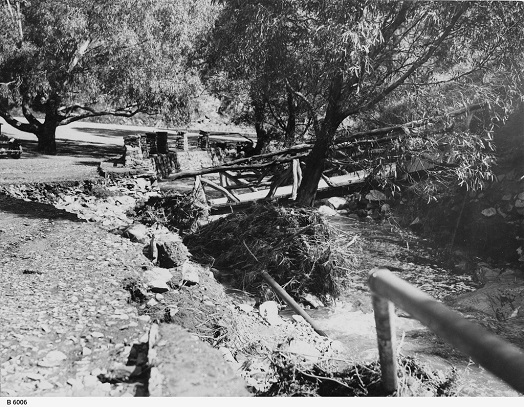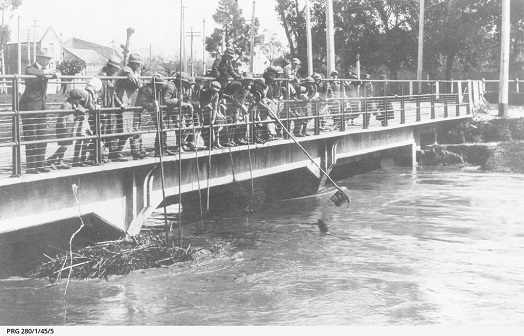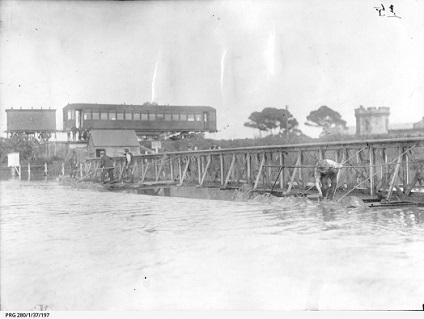The River Torrens
The usually benign River Torrens meanders 85kms from its source near Mt. Pleasant, through the Mt. Lofty Ranges and across the Adelaide Plains to empty into Gulf St. Vincent.
To the Kaurna people it was an important source of food and water. They called it “Karrawirra Pari,” meaning the river of the red gum forest. When in flood, they also called it “Yertala,” translated as “Water running by the side of a river.” 1
The availability of fresh water from the Torrens was one of the factors that influenced Colonel William Light's choice for the site of the new settlement of Adelaide. He also decided to name the river after Robert Torrens, the Chairperson of the Colonial Commission. In doing so, he overruled the name choice of the three men who had first come across the river in November 1836. They had named the river "Yatala," a corruption of the aboriginal word "Yertala." 2
The river soon became the primary source of fresh water for the settlement and unfortunately its main sewer. The settlers also came to understand that the river had a highly variable flow rate ranging from completely dry to trickles at times through summer and then sometimes a raging torrent during wet winters. “Yertala!!”
As the settlement grew, so did the need to make wise use of the water available from the river and minimise the damage caused by the flooding of the Torrens that occurred on an irregular and intermittent basis. In September 1844, the Adelaide Observer gave a detailed account of a disastrous flood along the Torrens. This was to be repeated many times over the next 100 years and gradually weirs and reservoirs were built, and a channel cut through the coastal sand dunes directly to Gulf St. Vincent to alleviate the flooding.3

Floods at Morialta Reserve in 1931
A broken bridge and debris can be seen after the 1931 floods at Morialta.
However, as we have seen as recently as September 2016, given the right weather conditions, the Torrens and its creek tributaries can still turn into a raging torrent and cause major damage.
Within the Campbelltown Council area, water from the Torrens River was used extensively to water the market gardens and orchards that thrived in the rich soil along the banks of the river. Walkers/cyclists on the Linear Park in the Paradise and Athelstone area can see a number of memorial plaques marking the sites of many of the families who worked the land along the river in the early days.
When flooding happened, soil, fruit trees, vegetable crops and anything else that wasn’t fixed would be washed away. In 1852 a Mr. Hutchinson of Athelstone had nothing left to show for his labour after a big flood carried his fruit trees and garden away. Not to be deterred he began a new garden but further from the river. Those living further down the river took the opportunity to collect driftwood and the fruit and vegetables floating by. In June 1898, the Advertiser reported that a six year old boy had been drowned in floodwaters whilst trying to retrieve an orange near the Hindmarsh Bridge.4, 5

The River Torrens September 1923
Following heavy rain men and boys on the Hindmarsh Tramway Bridge caught oranges in the River Torrens with improvised nets attached to long poles.

The Torrens in Flood 1923Men working at the Adelaide weir during flooding from the Torrens River
Another drowning occurred in 1889 when the City Surveyor, (Mr. Langdon,) and a Council employee, (Patrick McNamara,) were swept over the Torrens Weir. They had been standing on debris that had built up at the weir, and were trying to release a large log that had jammed a sluice screw. Without warning the debris they were standing on gave way and they were both swept over the weir into the raging torrent below. Mr. Langdon, the surveyor, surfaced and managed to swim to a rope thrown by nearby onlookers and was thus rescued. "How he managed to miss being dashed to pieces among the rocks or suffocated by the large waves is really to be wondered at." Unfortunately Patrick McNamara, a widower, who was said to have 6 children, was not seen again and no mention was made of his body being recovered further downstream. 6
At the time, this flood was considered the worst that had occurred since the arrival of white men, but then nearly 30 years later in 1917, the Advertiser reported in July, "The heavy rains in the hills and the Adelaide Plains have resulted in a flood which is proclaimed by many to be a record." 7
As recently as 1948, heavy summer rains across the state caused flooding and The Mail on Saturday 25 December reported on 3 young police constables stripping to their underwear and rescuing an Italian woman and child trapped in a buckboard on the Darley Road ford at Paradise. 8
Today the Torrens still supplies fresh water to Adelaide through the reservoirs located in the Adelaide Hills, but suburbia has replaced the orchards and market gardens that supplied fresh fruit and vegetables to the residents of Adelaide.
The Linear Park follows the Torrens from the hills to the sea and not only provides for flood mitigation and a transportation corridor from the north-east suburbs to the CBD, but is a wonderful area for recreational activities, particularly walking and cycling.
References
- Slsa.sa.gov.au. (2017). Manning Index of South Australian History. [online] Available at: http://www.slsa.sa.gov.au/manning/ [Accessed 11 May 2017].
- Slsa.sa.gov.au. (2017). Manning Index of South Australian History. [online] Available at: http://www.slsa.sa.gov.au/manning/ [Accessed 11 May 2017].
- Trove. (2017). LOCAL INTELLIGENCE. - Adelaide Observer (SA : 1843 - 1904) - 28 Sep 1844. [online] Available at: http://trove.nla.gov.au/newspaper/article/158919137 [Accessed 11 May 2017].
- Chronicle Saturday 30 April 1904 p 12
- Trove. (2017). FATALITY AT HINDMARSH. - The Advertiser (Adelaide, SA : 1889 - 1931) - 16 Jun 1898. [online] Available at: http://nla.gov.au/nla.news-article29409265 [Accessed 11 May 2017].
- Trove. (2017). FATAL ACCIDENT AT THE WEIR. - A CORPORATION EMPLOYEE DROWNED. - South Australian Chronicle (Adelaide, SA : 1889 - 1895) - 20 Apr 1889. [online] Available at: http://nla.gov.au/nla.news-article95149309 [Accessed 11 May 2017].
- Trove. (2017). HEAVY FLOODS - MUCH DAMAGE DONE TRAINS AND TRAMS STOPPED - The Advertiser (Adelaide, SA : 1889 - 1931) - 20 Jul 1917. [online] Available at: http://trove.nla.gov.au/newspaper/article/5536672 [Accessed 11 May 2017].
- Trove. (2017). Daring rescue in flooded river - (Continued from Page 1.) - The Mail (Adelaide, SA : 1912 - 1954) - 25 Dec 1948. [online] Available at: http://trove.nla.gov.au/newspaper/article/55901338 [Accessed 11 May 2017].
Further Information
The State Library of South Australia holds a number of interesting images of flooding along the Torrens over the years. These can be viewed online with a search for River Torrens floods.
Researched and compiled by Geoff Burton, a volunteer with the Campbelltown Library “Digital Diggers” group.
